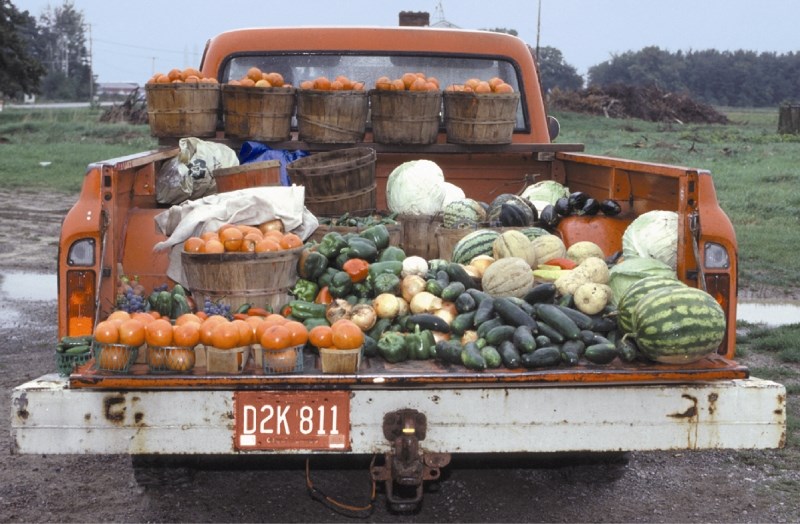A study released Sept. 15 shows that the average farmer’s share of the consumer’s food dollar increased by about one percent this year to 27.1 per cent.
Although this brings the farmer’s share back up to 2008 levels, many local farmers say the return they get on what they produce isn’t enough.
“We need some huge increases, and it will affect the consumer,” said local beef rancher Ron Hansen, 70. “Farmers are hard up and I don’t know what it is, but it is true all over the world, and we have to change that somehow.”
Hansen is concerned about the future of the family farm, given the negative profit margins that have been a reality since Bovine Spongiform Encephalopathy (BSE) was found in Canada in 2003.
“The majority of income for the farmer is off the farm,” said Hansen, adding that many farmers come home from their full time jobs and work all night and weekends to maintain their farms.
“If we don’t do something different quickly, there will hardly be any family farms in another… five to 10 years.”
According to Hansen, many farmers are selling acreages to supplement their income, to allow themselves to stay in the business.
Hansen says the solution is to cut subsidies and base the price of goods on a percentage of what it took to produce them.
“The consumer would determine whether or not we are out to lunch,” said Hansen.
“They are going to have to be willing to pay more, and if they aren’t, we shouldn’t be producing it (our goods).”
For three years, the Keystone Agricultural Producers (KAP) of Manitoba, Agricultural Producers Association of Saskatchewan (APAS), and Wild Rose Agricultural Producers (WRAP) of Alberta have been tracking the prices of an entire week’s worth of groceries for a family of four.
Each year, that information is compiled to increase awareness about what goes back to the farmer out of an average grocery bill.
“There is a lot of talk about increased costs at supermarket checkouts and that is why it’s important for us to do this study and offer a snapshot of how much money is going to the middleman or back to the producer,” said Ian Wishart, KAP president. “This study is valuable for explaining the farmer’s share to consumers.”
Researchers created a week-long menu, based on Canada’s Food Guide to Healthy Eating for two adults, a teenager and a child. The menu consisted of a variety of foods, 89 per cent of which was produced in Canada, ranging from a roast turkey dinner to oatmeal with strawberries and milk.
Less-processed foods such as vegetables often showed a greater return to the farmer. In the case of bread or other grain products, the actual return to the farm gate is extremely small.
The total food cost of this year’s menu before taxes was $198.95, up $4.12 from last year. Forty-four per cent of the budget was spent on fruit and vegetables. The study showed consumers are spending more and more of their budget on fruit and vegetables; specifically, the cost of apples, peaches and lettuce increased the most over the year.
The percentage of the study’s grocery money spent on grain products fell in 2009 and remained low this year. Money spent on milk and alternatives peaked in 2009, and returned to the 2008 level this year.
Depending on the food group, the farmer’s share percentage ranged from just over four per cent for grain products, to 51 per cent for milk and alternatives.
“Unfortunately, the farmer’s share of the food basket has not changed in the past three years,” said Humphrey Banack, president of WRAP. “Farmers need increased prices and an increased share of the consumer food dollar to be viable. Canadian farmers produce safe and high-quality food for little return and need to be better compensated.”
Long-time Springbank-area farmer Eric Longeway, 84, said he has seen many farmers in the area sell out in recent years.
He said it is getting increasingly difficult to make a living at farming.
“It is more or less just getting by and that is it,” said Longeway, adding that farmers have to contend with fluctuating profits, dependent on the year and the weather.
Longeway says there is no easy solution, but since he doesn’t favour government subsidies, he said the price of groceries would have to increase.
“It is about the only answer in a lot of ways, but it probably hits lower income people pretty hard,” he said.
According to Longeway, it is difficult for young people to get into farming, because of the high cost of land and equipment.
“I can’t go out and encourage people to make a living in farming,” said Longeway. “They are certainly going to have a hard time. You have to have a lot of money.”
Although he has seen many aspects of the industry decrease in the past, Longeway said it is important to maintain farmland.
“You take the value of land out here and it is just a laugh to think you should farm it,” said Longeway. “But I try to tell people we need farm land, or we aren’t going to be able to feed the people eventually. Our population is growing and all the land is getting bought up, so we have to rely on other countries to feed our people.”



